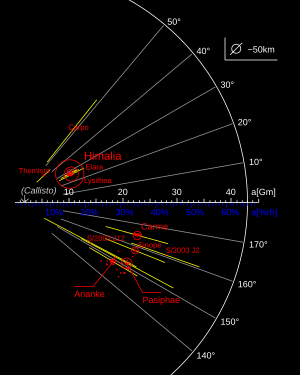Pasiphaë group facts for kids
The Pasiphaë group is a family of small moons that orbit Jupiter. These moons are not round like Earth's Moon. They all travel around Jupiter in a similar path. This path is called a retrograde orbit. This means they orbit in the opposite direction to Jupiter's spin. Scientists believe they all came from the same original object.
These moons are quite far from Jupiter. Their average distance is between 22.8 million and 24.1 million kilometers. They also have similar tilted orbits. Their orbits are tilted between 144.5 and 158.3 degrees. The shape of their orbits is also similar. They are not perfect circles, but more oval-shaped. This is called their eccentricity.

Meet the Pasiphaë Moons
The main moons in the Pasiphaë group are listed from biggest to smallest:
- Pasiphaë: This is the largest moon in the group.
- Sinope: This moon is about two-thirds the size of Pasiphaë.
- Callirrhoe
- Megaclite
- Autonoe
- Eurydome
- Sponde
The International Astronomical Union (IAU) is the group that names planets and moons. They have a special rule for moons that orbit backwards. All retrograde moons, including those in the Pasiphaë group, have names that end with the letter -e.
How the Pasiphaë Group Formed
Scientists think the Pasiphaë group formed a long time ago. They believe Jupiter captured a large asteroid from space. After it was captured, this asteroid likely broke apart. This happened because of a collision with another object.
The original asteroid was probably about 60 kilometers wide. This is roughly the same size as Pasiphaë today. Pasiphaë itself makes up most of the original asteroid's mass. It holds about 99% of it. However, if Sinope is also part of this group, then Pasiphaë holds a smaller share, about 87%.
The moons in this group have different colors. Pasiphaë is grey. But Callirrhoe and Megaclite are light red. These color differences suggest the group's origin might be more complex. It might not have been just one single collision.
See also
 In Spanish: Grupo de Pasífae para niños
In Spanish: Grupo de Pasífae para niños



